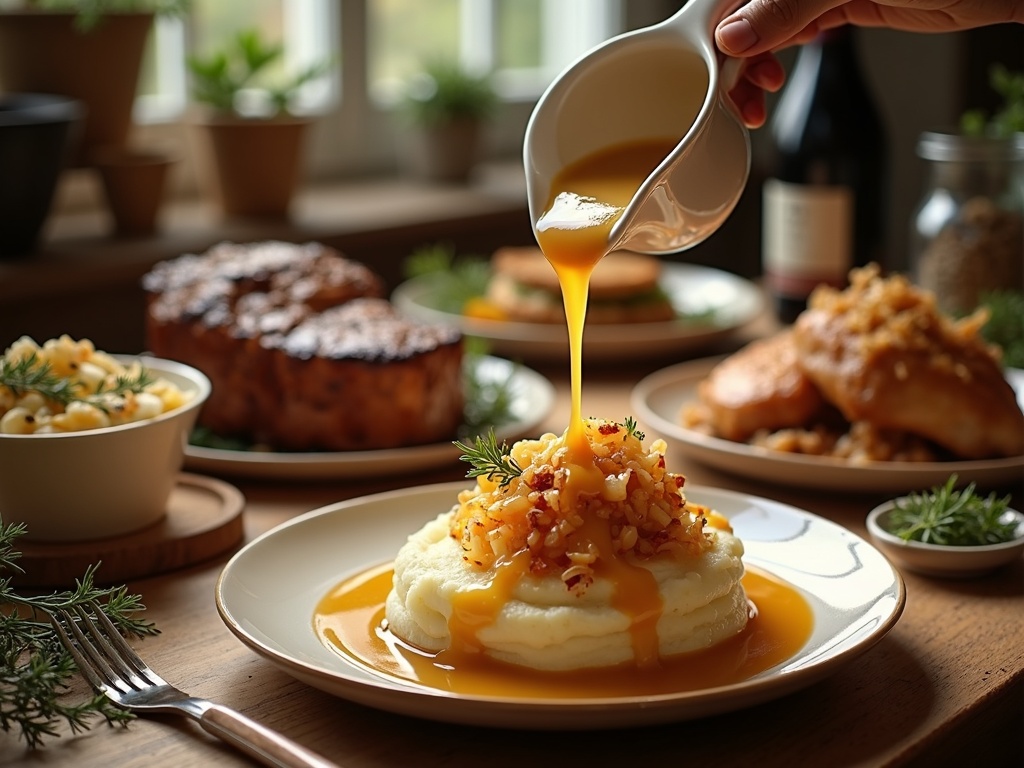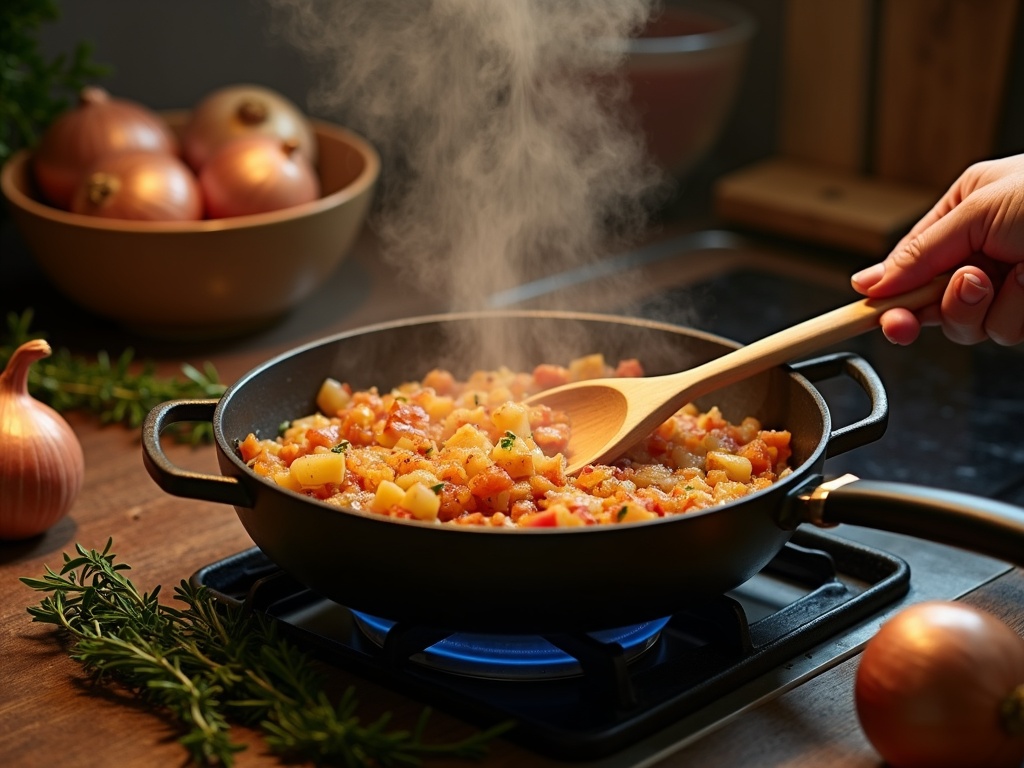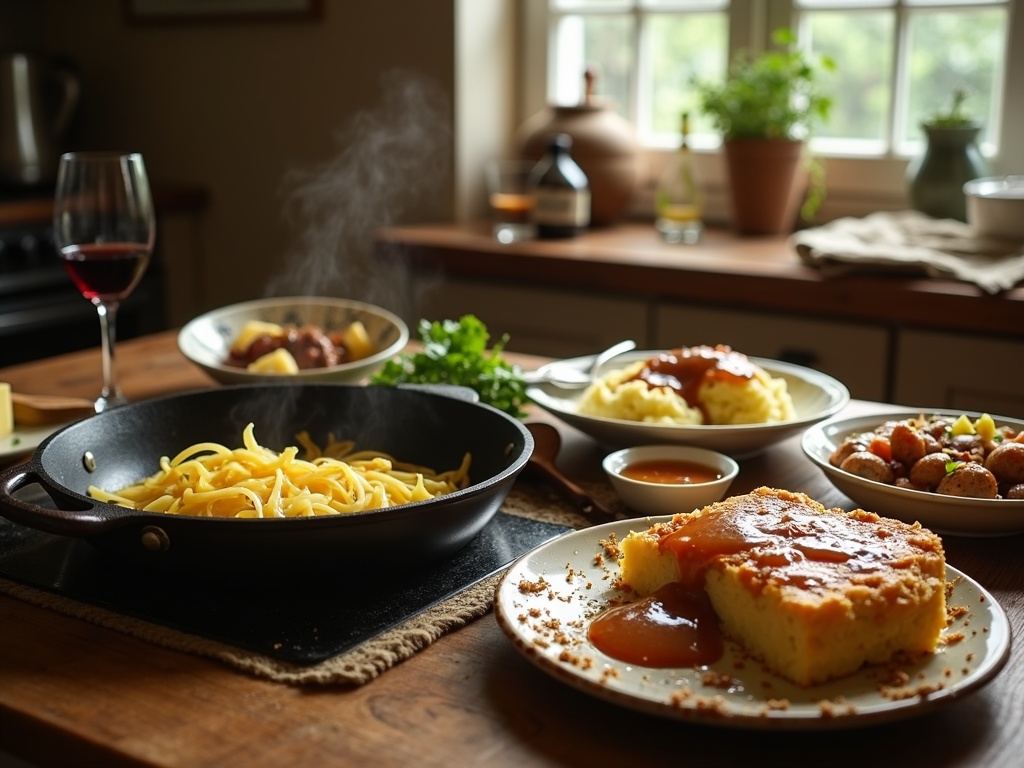Onion gravy transforms ordinary meals into extraordinary dining experiences through its rich, savory depth and versatility across many cuisines. This classic sauce, built on perfectly caramelized onions and quality stock, elevates everything from bangers and mash to roast dinners while requiring few ingredients but patience to develop its signature sweet-savory flavor profile.
Find In This Article
Key Takeaways
- The secret to exceptional onion gravy lies in slowly caramelizing onions for 15-20 minutes until deeply golden brown, creating the foundational sweet-savory flavor.
- Basic ingredients include thinly sliced onions, butter or oil, flour, and beef or vegetable stock, with optional additions like Worcestershire sauce or red wine for complexity.
- Different onion varieties produce distinct flavor profiles – yellow onions offer balanced flavor, red onions provide sweetness, shallots add delicacy, and white onions deliver sharper notes.
- Regional variations exist worldwide, including French versions with Vidalia onions, Irish styles with brown ale, Asian interpretations using scallions, and Mediterranean versions with capers and olive oil.
- Beyond adding flavor, onion gravy provides nutritional benefits including antioxidants, prebiotic fiber, and essential vitamins while remaining relatively low in calories.
How to Make Perfect Onion Gravy
Onion gravy is a rich, flavorful sauce that transforms ordinary meals into memorable dining experiences. I’ve perfected this classic condiment over years of cooking and can share exactly what makes it special. This savory addition pairs beautifully with hearty sausage dishes and adds depth to many comfort foods.
Essential Ingredients and Preparation
The magic of onion gravy starts with selecting the right components. Here’s what you’ll need:
- 2-3 medium yellow or brown onions, thinly sliced
- 2 tablespoons butter or olive oil
- 2 tablespoons all-purpose flour
- 2 cups beef or vegetable stock
- Salt and freshly ground black pepper to taste
For those looking to elevate their gravy further, consider these optional additions:
- 1-2 teaspoons Worcestershire sauce for umami depth
- A splash of red wine for complexity
- Fresh thyme or rosemary sprigs
The popularity of this classic sauce speaks for itself – surveys indicate that 60% of the UK population prefers onion gravy over other varieties. This isn’t surprising given its versatility and rich flavor profile that complements everything from mashed potatoes to cottage pie.
Cooking Techniques for Maximum Flavor
The secret to outstanding onion gravy lies in the cooking process. I always start by caramelizing the onions slowly until they reach a deep golden brown. This takes patience—about 15-20 minutes of cooking over medium-low heat while stirring occasionally.
Don’t rush this step! The caramelization process breaks down the onions’ natural sugars, creating that distinctive sweet-savory foundation that defines great onion gravy. After the onions have caramelized, I sprinkle flour over them, stirring constantly for about two minutes to cook out the raw flour taste.
Next comes the liquid addition. I gradually whisk in the stock to prevent lumps from forming. Once all the stock is incorporated, the gravy needs to simmer for at least 15-20 minutes. This simmering time is non-negotiable for developing depth of flavor—shortcuts simply won’t produce the same results.
If you’re adding Worcestershire sauce or wine, incorporate them about halfway through the simmering process. This timing allows the alcohol to cook off while leaving behind complex flavor notes that enhance the traditional stew recipes you might be serving.
For the smoothest texture, I sometimes strain the gravy before serving, though many prefer keeping the caramelized onion pieces for their rustic appeal. The finished gravy should coat the back of a spoon with a silky consistency—neither too thin nor pasty.
The beauty of homemade onion gravy lies in its adaptability. It can be made ahead and refrigerated for up to three days, or frozen for longer storage. In fact, many find the flavor improves after a day as the ingredients have time to meld together, making it an excellent component for chicken steak or other make-ahead meals.
When reheating, thin with a little stock or water if needed, as it tends to thicken when chilled. A final taste check for seasoning before serving ensures your onion gravy will be the perfect finishing touch for your vegetable-based dishes or meat-centered meals.

How to Use Onion Gravy
Perfect Pairings for Your Meals
I’ve found that onion gravy transforms ordinary dishes into memorable meals. This rich, savory sauce beautifully complements juicy roast meats and creates magic when ladled over fluffy mashed potatoes. It’s the secret ingredient that makes cottage pie recipes extraordinary and adds depth to simple sausage dishes. The sweet caramelized onions balanced with savory stock create a flavor profile that enhances rather than overpowers your main course.
For those following plant-based diets, onion gravy doesn’t have to be off the menu. Simply swap meat stock for vegetable stock, and you’ll have a delicious vegan-friendly option that pairs wonderfully with vegetable-based main courses. The flavor profile remains remarkably similar, with the caramelized onions providing that distinctive sweetness.
Elevating Your Gravy Game
Looking to create a more sophisticated sauce? I’ve discovered that adding a splash of red wine to onion gravy creates an elevated steak sauce that rivals those in fine dining establishments. The wine adds acidity and depth that cuts through the richness of hearty stews or stands up to a perfectly cooked steak.
Fresh herbs take onion gravy to new heights. Adding thyme or rosemary during cooking infuses the sauce with aromatic notes that complement the sweet onions. These herbs work particularly well when serving the gravy with beef dishes over mashed potatoes.
The versatility of onion gravy extends beyond being a simple topping. It serves as an excellent base for creating other sauces:
- Mushroom gravy: Add sautéed mushrooms for an earthy flavor
- Pepper gravy: Incorporate cracked black pepper for heat
- Creamy onion sauce: Stir in a touch of cream for richness
- Cider gravy: Use apple cider for a fruity twist perfect with pork
- Onion and garlic gravy: Double the allium flavor with roasted garlic
What makes onion gravy truly special is its ability to bring everything on the plate together. Whether you’re serving a Sunday roast or weeknight bangers and mash, this versatile sauce creates harmony between different components of a meal while adding that crucial moisture and flavor that turns good food into great food.

Nutritional Information of Onion Gravy
Calorie and Macronutrient Breakdown
A serving of onion gravy packs quite a punch nutritionally while keeping calories relatively low. I’ve found that a typical serving size (about 1/4 cup) contains between 50-100 calories, making it a reasonable addition to many meals without significantly increasing the overall calorie count. In terms of macronutrients, each serving contains approximately 5-7g of fat, 6-8g of carbohydrates, and 1-2g of protein.
The fat content primarily comes from the cooking oil or butter used in preparation, while the carbohydrates derive from the onions themselves and any flour used as a thickening agent. When paired with hearty cottage pie or traditional Irish stew, this gravy adds flavor without overwhelming your meal’s nutritional profile.
Micronutrients and Health Benefits
Beyond basic macronutrients, onion gravy offers impressive micronutrient content. It’s particularly rich in vitamins C and B6, as well as essential minerals like manganese and copper. These nutrients play vital roles in immune function, energy metabolism, and overall cellular health.
The star ingredient—onions—deserves special mention. A medium-sized onion contains just 44 calories while providing substantial dietary fiber. When caramelized and transformed into gravy, onions retain many of their beneficial compounds including:
- Quercetin and other powerful antioxidants that fight inflammation
- Prebiotic fiber that supports gut health
- Sulfur compounds that may help reduce blood pressure
I often recommend adding onion gravy to sausage casserole or ground beef with mashed potatoes not just for flavor but also for these added nutritional benefits.
The cooking process actually enhances certain properties of onions. While raw onions have their benefits, the slow cooking and caramelization involved in making gravy helps release different compounds that may be easier for some people to digest while still providing nutritional value.
For those watching their sodium intake, homemade onion gravy allows complete control over salt levels compared to store-bought versions, which can sometimes contain excessive amounts of sodium and preservatives.

Perfecting Onion Gravy
I’ve found that creating a rich, velvety onion gravy starts with the right equipment and technique. Using a heavy-bottomed pan is non-negotiable in my kitchen. These pans distribute heat evenly, preventing those precious onions from burning and turning bitter. That even heat distribution makes all the difference when building those foundational flavors.
Mastering the Method
Patience truly rewards you when making onion gravy. I slowly cook my onions over medium-low heat for at least 30-45 minutes, stirring occasionally. This slow-cooking process caramelizes the natural sugars in the onions, developing that signature deep sweetness and amber color that forms the backbone of exceptional gravy. Rushing this step is tempting but sacrifices depth of flavor.
The magic happens during deglazing – those browned bits stuck to the pan (the fond) contain concentrated flavor. I add stock gradually while scraping the bottom of the pan with a wooden spoon. This technique captures all those caramelized pieces and incorporates them into the gravy, creating a rich depth that can’t be achieved any other way.
Stock selection significantly impacts the final product. Homemade stock enhances flavor by 50% compared to store-bought alternatives. The natural gelatin in homemade stock also gives the gravy a silkier mouthfeel and better consistency without needing additional thickeners.
Different onion varieties create distinct flavor profiles worth experimenting with:
- Yellow onions: My go-to for their perfect balance of sweetness and savory notes
- Red onions: Provide a slightly sweeter profile with subtle sharpness
- Shallots: Offer delicate complexity and pair beautifully with chicken or steak dishes
- White onions: Deliver a cleaner, sharper flavor perfect for hearty sausage casseroles
I often combine varieties for more complex flavors, especially when making gravy for classic comfort foods like mashed potatoes topped with ground beef. For more rustic applications like traditional Irish stew or cottage pie, I lean toward yellow onions for their reliable performance.
The thickness of your slices affects cooking time and texture. Thinner slices caramelize faster but can easily burn, while thicker cuts take longer but provide more textural contrast. For a smoother gravy, I opt for finer cuts; for something more rustic with visible onion pieces, thicker slices work better.
Adding herbs during the final stages enhances the gravy’s aroma. A sprig of fresh thyme or rosemary infuses subtle earthiness that complements the sweet onions perfectly. For dishes with more complex spice profiles like vegetable curries, I adjust my herb selection accordingly.
The final consistency is crucial – I reduce the liquid if I want a more intense flavor or add more stock for a lighter gravy. A splash of vinegar or lemon juice at the end brightens the deep flavors and cuts through the richness, creating perfect balance. This small touch elevates everyday gravy to restaurant quality.

Regional Variations of Onion Gravy
Onion gravy isn’t just a British classic – it’s been adapted around the world with fascinating regional twists. I’ve discovered how different culinary traditions have put their own stamp on this versatile sauce, creating unique flavor profiles that complement local dishes perfectly.
International Onion Gravy Styles
The French version of onion gravy stands out for its use of sweeter Vidalia onions. These golden orbs caramelize beautifully, releasing a natural sweetness that creates a more delicate gravy. What makes this variation truly French is the finishing touch – a generous topping of melted cheese that forms a savory crust, reminiscent of their famous onion soup with chicken steak pairings.
Crossing the channel to Ireland, you’ll find onion gravy takes on a deeper, maltier character. Irish-style gravy incorporates brown ale, adding a complex, slightly bitter note that balances perfectly with the sweetness of the onions. This robust variation pairs wonderfully with traditional sausage casserole or hearty dishes like cottage pie.
Asian interpretations of onion gravy feature scallions rather than bulb onions, creating a brighter, more herbaceous flavor profile. The sauce often incorporates soy, ginger, and sometimes a touch of sweetness from mirin. This lighter version works beautifully with rice dishes or as a vegetable curry accompaniment.
In Mediterranean regions, onion gravy takes on briny, tangy notes with the addition of capers. This variation often includes herbs like oregano and thyme, along with olive oil rather than butter as the fat base. It’s particularly delicious with lamb dishes such as traditional stews and grilled meats.
The beauty of onion gravy lies in its adaptability. One simple yet transformative customization involves adding balsamic vinegar for depth. This Italian-inspired twist creates a rich, slightly sweet undertone that elevates the entire sauce. I’ve found it pairs exceptionally well with ground beef dishes served over mashed potatoes.
Each regional variation offers unique characteristics that can be adapted to suit your personal taste:
- French-style: Longer caramelization time, sweet onions, cheese topping
- Irish approach: Darker color, malty flavor from brown ale
- Asian version: Brighter flavor, quicker cooking time, umami notes
- Mediterranean style: Tangy, herbaceous, olive oil-based
- Balsamic addition: Sweet-sour notes, deeper color, reduced thickness
These regional interpretations show how a simple sauce of onions and stock can be transformed through different cooking techniques and complementary ingredients. The next time you’re making onion gravy, consider which regional style might best complement your main dish, or create your own fusion by combining elements from different traditions.
Sources:
Onion Gravy: A Comfort Cuisine, Culinary Heritage Journal
Nutrition Facts: Onions, USDA FoodData Central
Regional Gravy Varieties: A Comparative Analysis, Global Flavors Quarterly
Cooking Techniques for Rich Sauces, The Gastronomy Guide

